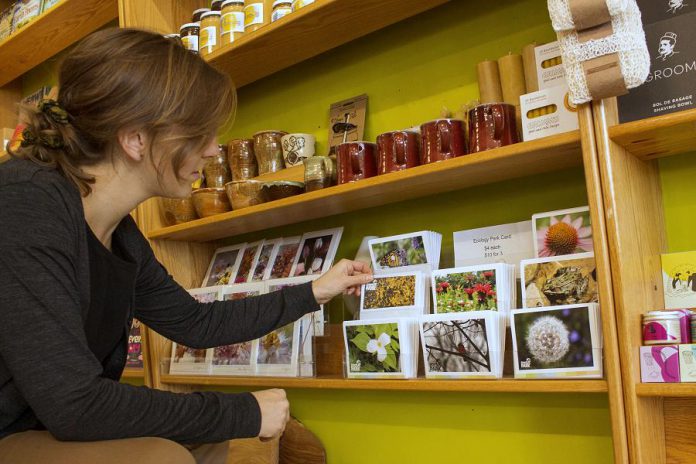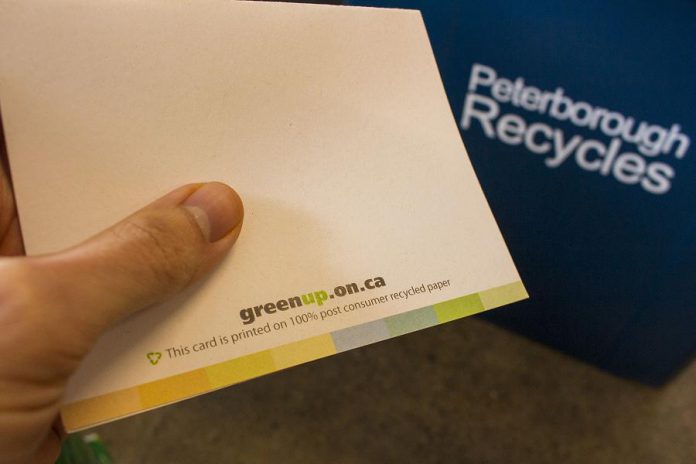
I was recently preparing some thank-you cards at the GreenUP office, and one of my colleagues commented that she doesn’t like cards because they are not useful after you receive them.
With Halloween over and Christmas coming, this got me thinking. Why do we give cards? How do cards impact the environment? Is it best to send cards in the mail, use e-cards, or connect with loved ones in person somehow?
The tradition of card-giving is old. Allegedly, the ancient Chinese and Egyptians were the first to begin this practice.
During the celebration of the Chinese New Year, it is traditional to send greetings as a way to protect loved ones from evil spirits. Starting in the 1400s, Europeans exchanged rather costly handmade cards for New Year’s and Valentine’s Day greetings, usually delivering them by hand. These early greetings were often reused to create scrap books for children in hospitals and missions.
Sir Henry Cole created the first commercially produced Christmas card in London in 1843. The card provided the fillable “To” and “From” fields that we are now very familiar with. The mass production of greeting cards began in the 1860s, and the advent of the postage stamp brought greeting cards to the masses.
Today, greeting cards are big business. Hallmark Cards Inc. takes about a third of this market in Canada and earned revenues of $401.7 million U.S. in 2016. But what happens to all of those cards when we are done with them?
First, the good news: most cards and envelopes are recyclable if they are made exclusively from paper, and some cards are made from entirely post-consumer recycled paper. There are now also cards with plant seeds embedded in the paper, so the card biodegrades in your garden, leaving only a gift of flowers!

The bad news is that any adornments like shiny or glossy materials, music players, glitter, metallic ink, or metal charms must be removed before the card can go in the recycling bin. Unfortunately, glitter and music players contribute to plastic pollution globally.
There are not readily available studies of the environmental impact of the greeting card industry in Canada. A recent study by Exeter University in the U.K. showed that sending one card produces about 140 grams of carbon dioxide. With about two billion cards sold annually in the U.K., that carbon footprint is roughly equivalent to manufacturing 10,000 cars per year.
With that impact in mind, how and why should we send greeting cards?
I consulted with some fellow GreenUP colleagues to find out their thoughts.
One enduring reason for sending cards is to symbolize how much you care about the person you are sending the card to.
“I like both sending and receiving greeting cards in the mail,” says Natalie Stephenson, GreenUP’s active school travel facilitator. “Sending a card shows a lot of thought and effort in this day and age.”
Ever since there have been commercialized cards, there have also been people who feel that mass-produced cards do not express their own unique sentiments.
“I am for the most part against spending any money on cards,” says Matthew Walmsley, GreenUP’s water education programs co-ordinator. “I always make my own cards, which have a mix of utilitarian design and personalized message, and they are well received.”

Recent technological advances allow people to create more customized cards.
“One of my friends makes postcards with a family picture instead of cards with envelopes,” said Karen O’Krafka, GreenUP water education programs coordinator. “That creates a bit less paper waste.”
Dawn Pond, GreenUP’s Depave and Vibrancy Project coordinator, prefers a minimalist approach to materials.
“I often use scraps of coloured card as gift tags,” she says. “I will write the messages on there, and omit the card from the gift altogether.”
What about digital replacements for physical cards?
“My mom uses e-cards,” explains O’Krafka. “I love them when they include a personalization like a picture.”
E-cards do save paper, transportation, and postage costs. That said, for some people e-cards still do not seem to convey the same symbolism as physical cards.
“I never use e-cards anymore,” Stephenson says. “I find them a bit cheesy, and people get so much email nowadays. I really prefer a small treat, a food gift like a cupcake or cookie or something of that nature that costs the same or less than a card. From a long-distance friend, my preference is to get a personal text (or email if need be) asking for a good time to chat and catch up for a few minutes by phone.”
Personally, I like the tradition of giving out cards as a token of thanks and to recognize special events. But like my colleagues, I try to consider the environmental impact of cards, usually by focusing on using recyclable paper materials without plastic adornments.

I like to add a handwritten message to store-bought cards that support a cause, such as the cards at the GreenUP Store that benefit Ecology Park programming, or cards made by local artists.
I do, however, find that when I receive cards they add to clutter in my space. Perhaps alternatives such as food, as Stephenson suggested, or a personal phone call, would create more authentic connections and add more to my emotional well-being than a card.
In the end, the tradition of sending cards is a personal choice, and our personal choices have global impacts.
How do you want to spread good will? As you prepare for the holiday season, share with @PtboGreenUP on social media what your environmental concerns and personal preferences are for giving and receiving cards. We look forward to hearing your perspective!


























